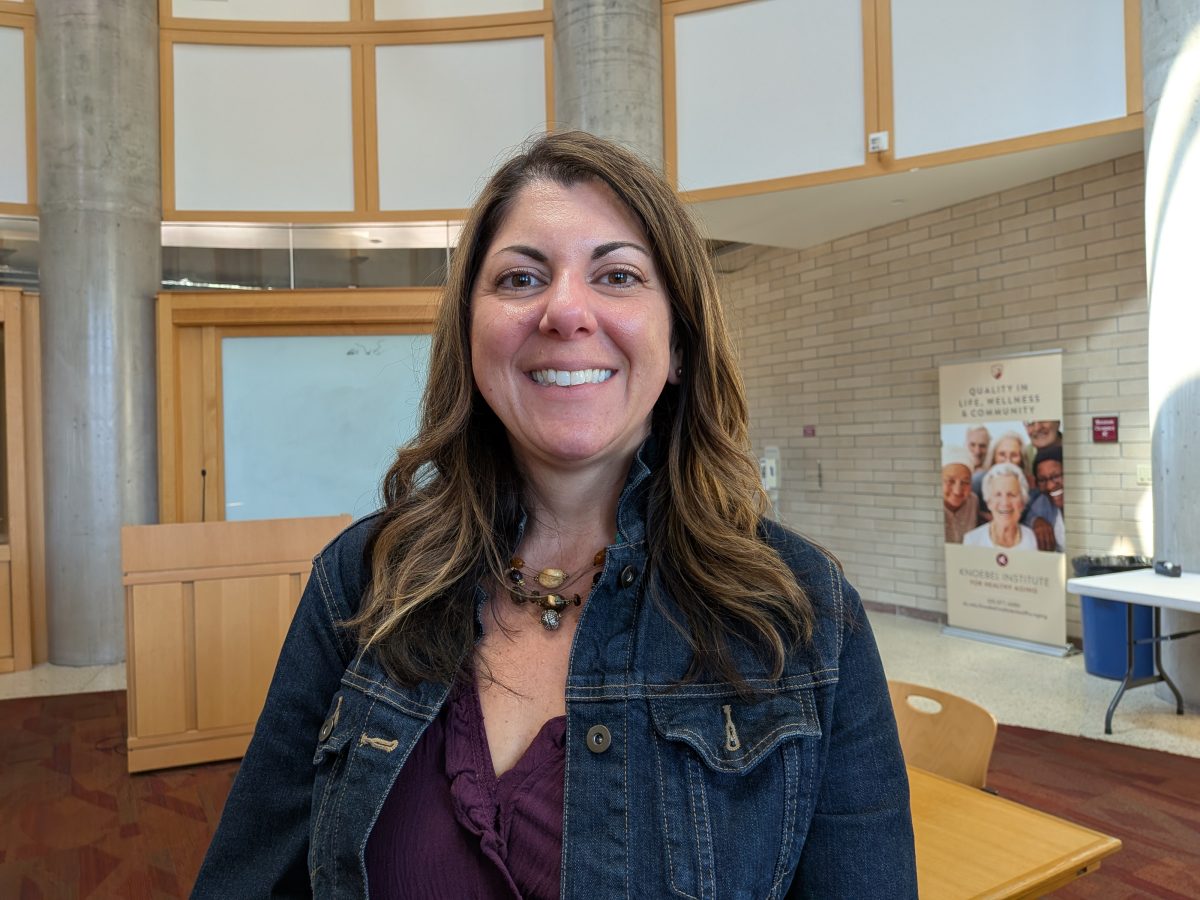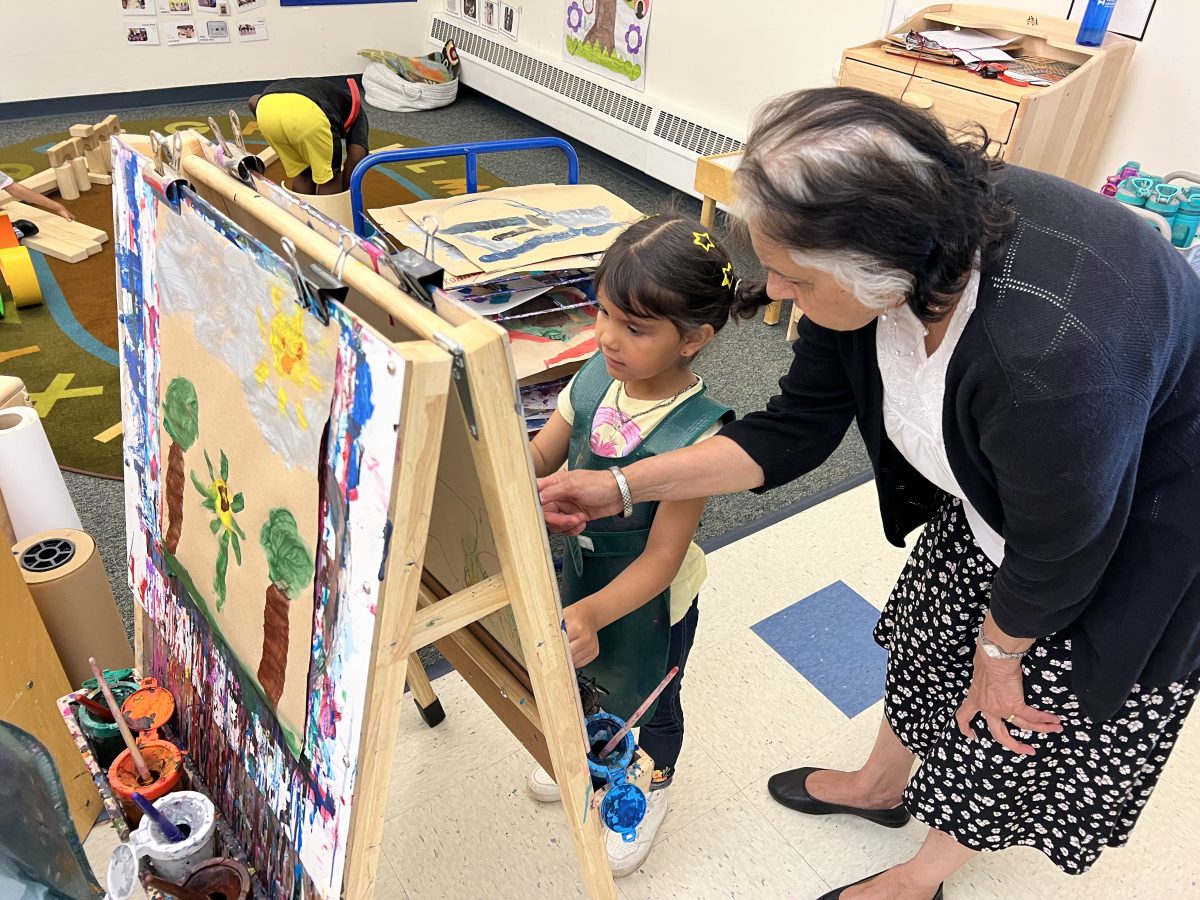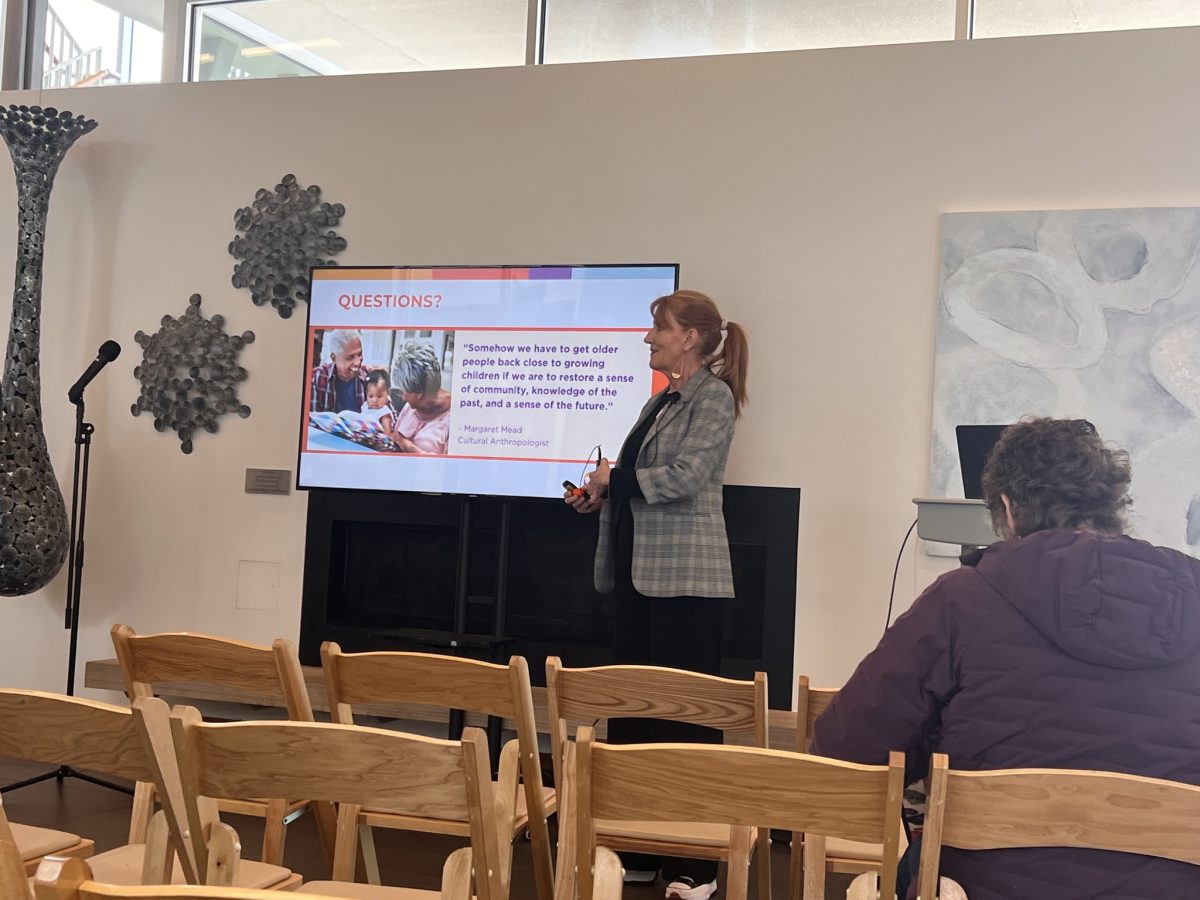Happy birthday, Renee Chalfant!
The redhead from Arvada turned 78 last week and she’s looking for a new job. Her last one ended last year when her nonprofit employer of more than a decade closed its Colorado office. She’d like to find a new part-time gig that’ll take advantage of her decades of experience as a bookkeeper, accountant and executive assistant.
A Colorado Sun series. Read more.
Colorado is getting older, rapidly. Are we prepared? We’re taking a look at how these shifting demographics are affecting housing, the workforce and quality of life, and whether Colorado has the services needed for people to age in place.
Yes, she’s nearly an octogenarian. No, she is not ready to retire.
If that doesn’t compute, set aside your beliefs about work, aging and retirement. We’re in a post-pension era. Social security and 401(k)’s may no longer cover the cost of life after work. Chalfant is single. She has a mortgage and a car payment. She needs additional income.
While there are fewer job openings nowadays than just a few years ago, it’s never been that easy to get hired when one’s resume is long and flowing, and hair has gone gray — or red.
“I have had three or four in-person interviews, which is very surprising, because I don’t pretend that I am not this old. My resume clearly shows my work history. However, I have not gotten a position,” said Chalfant, who also watches her grandchildren and serves on her HOA board (“Our insurance doubled”).
“It’s challenging for people who want to be in a professional career,” she said. “Realistically, it’s not going to be at the level you were before, but not as a greeter at Walmart or that sort of thing.”
Working past 65 and 70 may be one of the hottest trends in the labor market, especially in Colorado, which tied with Oregon for the third-fastest rate of aging nationwide. The number of Colorado workers 65 and older has more than doubled since 2010 and nearly quadrupled since 2000. About 1 in 5 Coloradans over age 65 are still part of the labor force today. In 2000, it was 1 in 8.
And the trend is not slowing down, said State Demographer Kate Watkins. One reason? Baby boomers, a generation that has had a lot of sway no matter what decade.
The eldest boomer turns 80 next year. That’s put increased attention for the past decade on aging, working longer and making Colorado a better place to grow older. In 2019, it led to establishing the Office of the Future of Work at the state labor department “to foster an economy that works for everyone in Colorado.” Earlier, workforce programs popped up like Careers for Adults Age 50+ in Denver and Generations@Work! from the Arapahoe/Douglas Workforce Center to help older job seekers reenter the job market or reskill.
In the next decade, the demographer’s office projects that the state will add an additional 230,000 residents who are 75 or older, which is up 56% from today’s roughly 420,000.
“A lot of older adults would like to be a part of the workforce, so finding ways to integrate that older adult population into the workforce is really critical for them, for their livelihood and for their finances,” Watkins said. “But it’s also critical for our economy and growing the economy, moving forward as more and more of our population are going to be in that 65-plus age cohort.”
Older workers and the economy
In Pitkin County, there was a growing concern that many county employees were nearing retirement age. So, three years ago, the county partnered with University of Iowa’s Age-Inclusive Management Strategies program to figure out how to retain and attract workers.
After surveying staff about retirement, the county conducted bootcamps to help existing staff plan for retirement. They also adopted practices like phased retirement to let older workers dip their toes into a less busy schedule while helping train their replacements.
 Melissa Knight, Pitkin County director of human resources and risk management. (Tamara Chuang, The Colorado Sun)
Melissa Knight, Pitkin County director of human resources and risk management. (Tamara Chuang, The Colorado Sun)
“We have a very long-tenured workforce. People, once they come in, tend to stay sometimes for their entire career,” said Melissa Knight, the county’s director of human resources and risk management. “So, in terms of all that knowledge, it was really important for us to capture that somehow.”
Phased retirement is an official status that needs board approval because it impacts the county budget. Essentially, the retiring employee moves to part-time or contract status and works alongside their replacement.
“There’s an overlapping period where the knowledge could be transferred as much as possible,” Knight said. “That’s been working really well for us. It actually ended up extending the employment of some of our retirees because they’re not necessarily ready to go 100% but they don’t really want to commit to working 40 hours a week.”
An added bonus? They’re getting more applicants. It’s helped build the county’s reputation as “an employer of choice in the valley,” she said. Recently, one opening attracted “52 applicants, which is pretty high for us,” she said. “In 2022, we may have gotten two or three.”
A Pew Research Center study in 2023 found that 19% of adults age 65 or older were still working, compared with 11% in 1987. Contributing reasons were that older adults were healthier than in the past; retirement plans — like 401(k)’s — discouraged early retirement, unlike pension plans; and changes around Social Security, which raised the age to qualify for full benefits to 67. It had been 65, an age picked by a Presidential committee back in 1935 based on the prevailing retirement age of private pensions at the time, as well as actuarial studies.
It also costs more today to live in Colorado with some expenses rising faster than the rate of inflation, which Social Security increases are based on. This year, Social Security’s cost of living allowance pushed checks up 2.5%, but the cost of housing in the Denver area was up 2.9%.
We charted the cumulative increase of Social Security payments compared to the Consumer Price Index for housing and medical costs in Denver since 1977. Social Security payments are up 173%, while housing costs have increased 210% and medical is up 274%.
Next50, a Denver foundation that funds efforts to create a world that values aging, said it’s more expensive to age in Colorado than many other states.
Nearly half of Colorado’s older adults live below the Elder Index, which was created by the Gerontology Institute at the University of Massachusetts Boston to measure how much income is needed to meet basic needs of older adults. Colorado housing costs are also 20% more than the national average, and 37% more in Denver. Incomes of Coloradans 65 and older have grown by just 10% since 2010, according to a new Next 50 report titled, “Aging at Altitude: Why It’s Expensive to Age in Colorado.”
Retaining older workers provides that financial benefit to individuals who earn more than they would on Social Security. But it also benefits the employer, said Sydney Byer, who authored the report.
“Right now, in general, we have five generations in the workforce,” Byer said. “There are benefits to having each different generation in the workforce.”
Employers tend to gravitate to the “young and scrappy” who are more apt to leave for a new job than older workers, she said. Meanwhile, older adults, who can offer mentoring and stability, typically stay in jobs longer but are overlooked. The mix is important, she added.
“We need more workers that are in every kind of industry,” she said. “Companies really have an opportunity to bring older adults up to speed because they want to learn again, generally. And they want to be able to find meaning in their work.”
What jobs are out there?
While the over-60 set of job seekers may feel relegated to entry-level retail openings or volunteering, there are sites geared toward older workers.
RetirementJobs.com has its share of retail openings, but there’s also several in Colorado asking for seasoned applicants, including a histotechnician at Quest Diagnostics, a senior therapeutic area specialist, or an insurance filing specialist.
Over at WAHVE, short for Work At Home Vintage Experts, the contract staffing company focuses on retired insurance industry professionals who could take on an extra client or two.
And there’s self-employment.
Ann la Plante, a 71-year-old self-employed attorney in Greeley, works about 15 hours a week, down from 48 hours just before the pandemic. She works with tenants and landlords so she lost work during COVID when eviction bans were in place.
“Three years ago, I don’t think I realized that it was a choice. But now I know it’s a choice,” said la Plante, who’s practiced law in Weld County for 40 years. “I’m enjoying the less-stressful life.”
She recently renewed her malpractice insurance policy and attended a DUI seminar to stay updated. She doesn’t see herself fully retiring anytime soon.
“Because I still want to learn,” she said. “I still want to know what’s going on. I still want to meet people while doing it. It’s social as well as learning. But I’m enjoying being a little calmer.”
But for folks who are in a situation like Chalfant and starting from scratch, it’s difficult to get an employer’s attention. Ageism seems rampant, she said.
 Arvada resident Renee Chalfant, nearing her 78th birthday, was recently laid off from her longtime bookkeeping job, July 24, 2025. With decades of experience and strong computer skills, Chalfant has no desire to retire but says finding meaningful work at her age has proven to be an uphill battle. (Kira Vos, Special to the Colorado Sun)
Arvada resident Renee Chalfant, nearing her 78th birthday, was recently laid off from her longtime bookkeeping job, July 24, 2025. With decades of experience and strong computer skills, Chalfant has no desire to retire but says finding meaningful work at her age has proven to be an uphill battle. (Kira Vos, Special to the Colorado Sun)
“Unfortunately, I think their assumptions are inaccurate,” Chalfant said, when sharing her experience of job hunting. “They’re asking questions like, ‘Have you ever worked on a computer?’ And I’m like, hey, you know, I’ve taken classes in AI. I’ve got two laptops and my phone. You can’t assume because you have a person of a certain age that they’re not technically apt.”
Without prior connections, it can be a challenge to find a new job at any age. The good news is that more employers have taken efforts to become an age-friendly workplace in hopes of attracting and retaining older workers.
The Age Friendly Institute, which is behind RetirementJobs.com, also created a Certified Age Friendly Employer, or CAFE, designation. The process checks benefits, wording of internal policies and the number of employees over 50. It looks at whether employee knowledge and maturity is valued, provides equitable pay to older workers and has age-friendly external messaging, such as branding photos that show a mixed-age group of workers instead of just younger workers.
“There’s been an extreme number of government organizations seeking out certification,” founder Tim Driver said. “(Newly certified) California has been vocally broadcasting this achievement for the purpose of attracting workers to state government jobs in California. … They want to not only attract people into government jobs but they are interested in helping people stay in the economy. Because if they’re earning, it means they’re most likely spending and that’s good for the state.”
Since late 2021, the number of certified age-friendly employers has doubled to about 250 nationwide.
“There’s a ton more attention on this topic since we started Retirement Jobs 20 years ago,” Driver said. “But it’s also fair to say that it’s still an uphill battle for older job seekers. I mean they’re certainly aided by our program (but) it’s still difficult, no matter what your age is. … Oftentimes, the best advice I have for younger people is to maintain your networks because that is the best way to find new work at any age.”
Intergenerational at play
For many older workers, it’s not just about working to make ends meet.
Sunanda Babu, who is 73, spends three days a week helping a child care center in Denver’s Lowry neighborhood. She’s often tapped to be a substitute or floater while other teachers go to lunch.
It pays just above minimum wage, and includes some benefits. It’s part time and just a few hours a day, which is perfect for her. Her husband is retired.
 Sunanda Babu, 73, spent decades as a researcher supporting studies on childhood diabetes and looking at genetics. When the work ended, she found herself looking for something else to do before finding a new career with the Early Childhood Service Corps, which trains older workers and places them at nearby childcare centers. (Handout)
Sunanda Babu, 73, spent decades as a researcher supporting studies on childhood diabetes and looking at genetics. When the work ended, she found herself looking for something else to do before finding a new career with the Early Childhood Service Corps, which trains older workers and places them at nearby childcare centers. (Handout)
“For me, it’s not really for the money,” said Babu, who lives in Aurora. “With my retirement and my annuity from Social Security, we’re comfortable. This is pocket money if we want to go on a trip or something. And prices are going up so I do dip into that.”
She enjoys it. But if she’d be able to stay at her last job supporting researchers at the University of Colorado Anschutz Medical Campus, she believes she’d still be doing that today.
Babu, who has a Ph.D. in botany, was part of the support staff for researchers looking into childhood diabetes. She focused on genetics. But when the lead researcher passed away, the grants ended and she lost her job of 27 years, just before COVID.
She sat out during the worst of the pandemic but wanted to get back into doing something, even volunteering. Then she spotted a Colorado Sun story about a new preschool program that was seeking healthy, older Coloradans interested in a part-time intergenerational workplace. Babu applied and got in.
The program, called the Early Childhood Service Corps, provides free training to people over 50 and offers access to college-level coursework that is needed to work as a teacher or substitute in preschool classrooms. And it matches up trainees to preschools in need as either paid staff or volunteers.
It’s the brainchild of Lisa Armao, who has a background in Montessori leadership. Tapping into the older workforce was a way to not only provide jobs to older adults who had a hard time getting noticed by employers, but help an industry that struggled with low pay, high turnover and finding staff.
 Lisa Armao founded the Early Childhood Service Corps, to train older or retired adults to be preschool teachers or substitutes. The intergenerational program has helped not just the older adults but the children, families and fellow teachers. (Handout)
Lisa Armao founded the Early Childhood Service Corps, to train older or retired adults to be preschool teachers or substitutes. The intergenerational program has helped not just the older adults but the children, families and fellow teachers. (Handout)
The program has trained 118 people so far and this year, it added a summer cohort as it expands to three training sessions a year.
“I knew that older adults would enjoy being with children and I knew that children would enjoy being with older adults and having a grandparent in the classroom,” Armao said. “But the thing that’s happening, which is just beautiful and I should have seen this coming, is the thread between all the other staff of varying ages, the parents who were younger and the connections that are happening with our older adults.”
And for such programs, she added, “I really believe that intergenerational interaction, workspaces, programming and friend groups, that’s really how we’re going to stop ageism.”
As for Babu, she still gets to use her skills from a past job life.
“I’m a researcher so I’m always learning a lot by observing the kids. I’m fascinated by their development,” she said. “I tell you the truth. Once I came to preschool, I said, ‘OK I don’t need to look young anymore.’ I stopped dying my hair. … The 70s are the new 60s. As long as I have my health, I can work.”
Type of Story: News
Based on facts, either observed and verified directly by the reporter, or reported and verified from knowledgeable sources.


